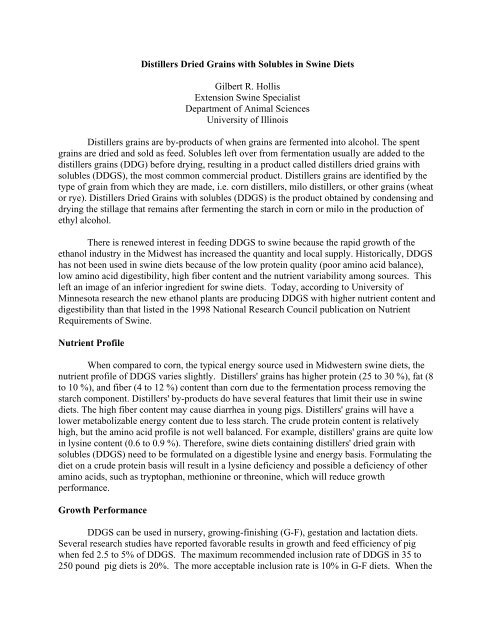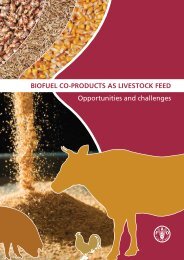Distillers Grains Feeding Recommendations. - Distillers Grains By ...
Distillers Grains Feeding Recommendations. - Distillers Grains By ...
Distillers Grains Feeding Recommendations. - Distillers Grains By ...
You also want an ePaper? Increase the reach of your titles
YUMPU automatically turns print PDFs into web optimized ePapers that Google loves.
<strong>Distillers</strong> Dried <strong>Grains</strong> with Solubles in Swine DietsGilbert R. HollisExtension Swine SpecialistDepartment of Animal SciencesUniversity of Illinois<strong>Distillers</strong> grains are by-products of when grains are fermented into alcohol. The spentgrains are dried and sold as feed. Solubles left over from fermentation usually are added to thedistillers grains (DDG) before drying, resulting in a product called distillers dried grains withsolubles (DDGS), the most common commercial product. <strong>Distillers</strong> grains are identified by thetype of grain from which they are made, i.e. corn distillers, milo distillers, or other grains (wheator rye). <strong>Distillers</strong> Dried <strong>Grains</strong> with solubles (DDGS) is the product obtained by condensing anddrying the stillage that remains after fermenting the starch in corn or milo in the production ofethyl alcohol.There is renewed interest in feeding DDGS to swine because the rapid growth of theethanol industry in the Midwest has increased the quantity and local supply. Historically, DDGShas not been used in swine diets because of the low protein quality (poor amino acid balance),low amino acid digestibility, high fiber content and the nutrient variability among sources. Thisleft an image of an inferior ingredient for swine diets. Today, according to University ofMinnesota research the new ethanol plants are producing DDGS with higher nutrient content anddigestibility than that listed in the 1998 National Research Council publication on NutrientRequirements of Swine.Nutrient ProfileWhen compared to corn, the typical energy source used in Midwestern swine diets, thenutrient profile of DDGS varies slightly. <strong>Distillers</strong>' grains has higher protein (25 to 30 %), fat (8to 10 %), and fiber (4 to 12 %) content than corn due to the fermentation process removing thestarch component. <strong>Distillers</strong>' by-products do have several features that limit their use in swinediets. The high fiber content may cause diarrhea in young pigs. <strong>Distillers</strong>' grains will have alower metabolizable energy content due to less starch. The crude protein content is relativelyhigh, but the amino acid profile is not well balanced. For example, distillers' grains are quite lowin lysine content (0.6 to 0.9 %). Therefore, swine diets containing distillers' dried grain withsolubles (DDGS) need to be formulated on a digestible lysine and energy basis. Formulating thediet on a crude protein basis will result in a lysine deficiency and possible a deficiency of otheramino acids, such as tryptophan, methionine or threonine, which will reduce growthperformance.Growth PerformanceDDGS can be used in nursery, growing-finishing (G-F), gestation and lactation diets.Several research studies have reported favorable results in growth and feed efficiency of pigwhen fed 2.5 to 5% of DDGS. The maximum recommended inclusion rate of DDGS in 35 to250 pound pig diets is 20%. The more acceptable inclusion rate is 10% in G-F diets. When the
















